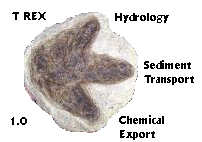
TREX: Two-Dimensional Runoff Erosion and Export
Spatially Distributed Model To Assess Watershed Hydrology, Sediment Transport, and Contaminant Transport and Fate
TREX (as well as CASC2D and CASC2D-SED before it) has been used for projects within the U.S. and internationally. A number of very interesting and informative applications have also been developed by research groups working independently of, or sometimes in collaboration with, the TREX development team to create entirely new models that address environmental problems in ever more diverse conditions and settings. The list of projects where TREX has been used or adapted for other purposes includes:
Lea Dreier: Evaluation of the Allgemeine Bodenabtragsgleichung (ABAG) under the direction of Dr. Björn Tetzlaff, Research Centre Jülich (FZJ) and Dr. Jens Gross, Leibniz University Hannover (LUH).
Lezhang Wei, Tsuyoshi Kinouchi and colleages at Tokyo Institute of Technology: development of an enhanced model to simulation soil erosion and transport of 137Cesium in forested catchments affected by the Fukushima Dai-ichi Nuclear Power Plant accident.
Wei, L., Kinouchi, T., Yoshimura, K., and Velleux, M. 2017. Modeling watershed-scale 137Cs transport in a forested catchment affected by the Fukushima Dai-ichi Nuclear Power Plant accident. Journal of Environmental Radioactivity, 171:21-33.
Wei, L., Kinouchi, T., Velleux, M., Omata, T., Takahashi, K., Araya, M. 2017. Soil erosion and transport simulation and critical erosion area identification in a headwater catchment contaminated by the Fukushima nuclear accident. Journal of Hydro-environment Research, 17:18-29.
Yi Hong and researchers at the École des Ponts, Agro Paris Tech: creation of a new framework combining 2-D surface processes from TREX with the 1-D pipe flow model CANOE.
Hong, Y., Bonhomme, C., and Chebbo, G. 2016. Development and assessment of the physically-based 2D/1D model "TRENOE" for urban stormwater quantity and quality modelling. Water, 8, 606; doi:10.3390/w8120606.
Andy Steininger: Simulation of dam break and flood wave scenarios using TREX to ascertain the model’s range of applicability to these types of events, Colorado State University (2014).
Jazuri Abdullah (Universiti Teknologi MARA, Malaysia) and colleages: Use of TREX to simulate extreme floods for watersheds of different sizes, evaluation of Probable Maximum Precipitation (PMP) and Probable Maximum Flood (PMF) conditions.
Abdullah, J., Muhammad, N., Julien, P., Ariffin, J., and Shafie, A. 2016. Flood flow simulations and return period calculation for the Kota Tinggi watershed, Malaysia. Journal of Flood Risk Management, 9(4), 10.1111/jfr3.12256.
Abdullah, J. and Julien, P. 2014. Distributed flood simulations on a small tropical watershed with the TREX model. Journal of Flood Engineering, 5(1-2):17-37.
Un Ji and colleages at Myongji University and the Korea Institute of Construction Technology (KICT): use of TREX for critical erosion source area evaluation.
Ji, U., Velleux, M., Julien, P., and Hwang, M. 2014. Risk assessment of watershed erosion at Naesung Stream, South Korea. Journal of Environmental Management, 136(1):16-26.
James Halgren: Combined TREX with the National Weather Service River Forecast System's Sacramento Soil Moisture Accounting (SAC-SMA) model to create TREX-SMA, Colorado State University (2012).
Home | Overview | Applications | User Manual | Source Code | Examples | TREX Tools | Research | Contacts | USEPA SAP Review
Department of Civil and Environmental Engineering
-
Colorado State University
Fort Collins, Colorado 80523-2028 USA (970) 491-5048
Last update: 07 August 2018